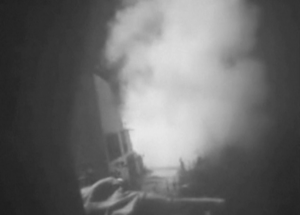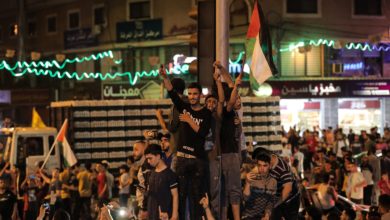
In a dangerous development on Oct. 13, the United States fired three Cruise missiles from the warship Nitze at radar installations in Yemen. While the Pentagon asserted that Houthi rebels had been firing missiles at the U.S. warship Mason in the Gulf of Oman, it is truly horrific that the U.S., with the world’s largest military, is using missiles to “protect itself” against the poorest nation in the region, which itself is currently wracked by a multi-party civil war and has been under aerial bombardment by Saudi Arabia since March of 2015.
The United States has been supporting the Saudi bombing campaign—which has killed 4,000 civilians and created a massive humanitarian crisis– since its inception. Last week, the Saudis killed at least 140 civilians attending a funeral in Sana’a in a horrific massacre.
Massacre at funeral in Sana’a
The New York Times reported that the Saudis repeatedly bombed the reception hall:
Tamim al-Shami, a spokesman for the Health Ministry, said at least 104 people had been killed and 550 wounded. He added that the death toll was likely to rise, as rescuers were still working to remove bodies from the rubble.
“There are charred bodies, and some were cut to shreds and couldn’t be identified,” Mr. Shami said, adding that children were among the victims.
U.S. role
While talking about brokering a peace deal, the United States has refueled some 5,700 Saudi bombing missions. It is no surprise that Yemeni forces defending their country against the Saudi aggression are now also targeting U.S. warships that are “patrolling” waters near Yemen—they see that the U.S. is financially and militarily supporting Saudi Arabia, the country that is causing so much damage to their own. Most recently, the U.S. concluded a $1.15 billion arms deal with Saudi Arabia.
“The Americans have been patronizing and directing the war from the very beginning,” said Brig. Gen. Sharaf Luqman, a spokesman for the rebel alliance. (NYT, 10/13)
Yemen has been engaged in a complex, multi-party civil war for some years. The Houthis, a rebel group that originated in the North of the country, initially fought for greater autonomy. At the same time, a movement in the South was also seeking greater autonomy or independence.
Simultaneously, Al-Quaeda in the Arabian Peninsula was gaining strength. After the collapse of the U.S.-backed Ali Abdullah Saleh regime following ‘Arab Spring’ protests, the Houthis filled the power vacuum by seizing the capital of Sana’a then driving South to Aden—until the Saudi bombing campaign began with the stated goal of reinstating the Abd Rabbuh Mansur Hadi government. Formerly enemies, the Houthis and Saleh have now joined forces against the Saudis.
Houthis and Iran
In response to the U.S. missile attacks on targets in Yemen, Iran has moved warships to the Bab el-Mendeb, the strait at the mouth of the Red Sea. Over the course of the Yemeni conflicts, the Saleh government and later the Saudis have claimed that the Houthis are a proxy force for Iran in Yemen. Those who are more knowledgeable about Yemen are not so quick to accept this assertion, noting that the Houthis, while nominally Shia, have their own political agenda and uniquely Yemeni religious orientation.
The Yemeni people are suffering tremendously as a result of the U.S.-supported Saudi bombing war. Now, the U.S. is directly intervening in the conflict with its most recent action. This is a very dangerous development with the potential to enlarge the already horrific conflict into a much wider war.
Progressive people should demand an immediate end to U.S. military and financial support to Saudi Arabia, and the immediate withdrawal of U.S. troops, warships and the closure of bases from the region, and support the right of the Yemeni people to self-determination.





